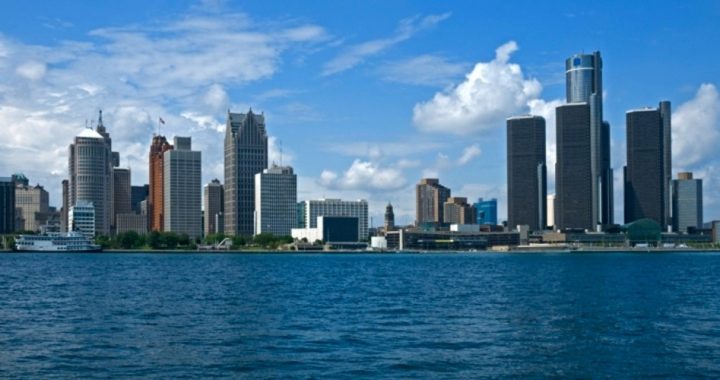
On the surface, last Friday’s announcement by Michigan Governor Rick Snyder that Detroit’s financial situation was so grievous that a special emergency financial manager (EFM) would have to be appointed to take over from the city council appeared to be the end of the line for a once great city.
A city that was once the fifth largest and wealthiest in the country, Detroit appears to have hit bottom. It has lost nearly 60 percent of its population since its peak in 1950, its tax revenues have declined by $100 million in just the last decade, and one-third of Detroiters now live in poverty. So cataclysmic has been the decline that the governor is having trouble finding someone willing to take on the job of Detroit’s EFM.
Mara MacDonald, a local TV reporter who is close to the epicenter of the Detroit disaster, wrote: “There is no possible way for Detroit to fix its long-term liabilities and short term cash burn without the assistance of an emergency financial manager and possibly a bankruptcy judge.”
The numbers are indeed appalling. According to Snyder, Detroit has a $327-million budget deficit and more than $14 billion in long-term debt. And this is somehow to be serviced by a population of just 700,000 people, many of whom don’t pay taxes, or refuse to. There are 77 blocks in the city where just one taxpayer pays his real estate taxes. The photographs of decrepit residences are commonplace. Just type “Detroit Disaster” into YouTube. Even banks are walking away from their own REOs.
The city set another record: It just reported its highest homicide rate in 20 years. More people were killed in Detroit during a period of time when the city’s population was declining and gun crimes nationally were also declining. David Martin, director of the Urban Safety Program at Detroit’s Wayne State University, noted, “At least two-thirds of the homicides in Detroit are related to drug sales, disputes between people selling drugs or disputes between people owing people money about drugs.
Detroit has another sad record: In 2012 it had the highest rate of violent crime of any city over 200,000 population in the country, according to the FBI.
Part of the problem may well be the size of government payrolls due to disproportionately large public-sector employment. Out of the top 15 employers in the city, six of them are government offices or government-related. When measured by employment, those six account for nearly half of all jobs in the top 15. And most of them are unionized.
Another part of the problem is corruption. During the 20-year tenure of Coleman Young, Detroit’s radical leftist mayor, his chief of police and political ally, William L. Hart, went to prison for 15 years for stealing $1.3 million of police department funds. Hart’s deputy, Kenneth Weiner, learned how to dip into the same fund and was caught and convicted as well, going to prison for five years for stealing twice as much as his boss. Young miraculously escaped being charged.
Still another part of the problem is union power. Justice Croise, a liberal, pro-Obama Detroiter who nevertheless saw the problem, explained:
I’m a native Detroiter (born and raised), lifelong Democrat, and I voted for President Obama (twice), so I am well aware how “republican” my stance on Detroit is, but having been on the inside of City Hall I have the first-hand experience to tell you that waste, fraud, ineptitude, selfishness, and a complete lack of personnel and financial management controls are holes in Detroit’s boat which no amount of bailing can keep afloat….
Fundamentally obsolete union contracts … falsely protect undeserving workers and processes … usurp the city’s ability to manage operations effectively and efficiently.
Another Detroit insider, Nancy Flanagan, with 30 years of experience as a teacher there, attended a meeting last month about Detroit’s difficulties where a panelist described the effects these problems were having on Detroiters. Said the panelist:
There are 50,000 homeless people in the city. There are 30,000 houses with no running water, 10,000 occupied homes with no power, and 40,000 houses in foreclosure.
One-third of the land in the city is empty, vacant — and there’s no supermarket in the city limits, so 90% of purchased “food” comes from 7-11s, gas stations and fast food outlets.
Burned-out houses are everywhere, and there are entire neighborhoods where unemployment is universal.
Kevin Williamson, a journalist at National Review, said last June that there are at least three lessons to be learned from the destruction of Detroit. First, allowing unions to dictate employment terms always results ultimately in disaster. Second, there are limits to the effectiveness of tax increases. At some point taxes become so onerous that the taxpayers leave. That explains at least part of the flight to the suburbs from downtown Detroit. Third, he wrote, is morality. Without some sense of trust and confidence in existing structures of society, no one will participate. Wrote Williamson:
Detroit’s institutions have long been marked by corruption, venality, and self-serving. Healthy societies have high levels of trust.
Who trusts Detroit? People do not invest in firms, industries, cities or countries they do not trust. Corruption makes people poor.
And yet. And yet. Despite all of the bad news being sung like a dirge over the funeral pyre of a loved one, there is, as Forbes magazine puts it, a “secret revival” taking place right in the center of town. Anneke Jong, who describes herself as a social entrepreneur and strategic consultant, saw with her own eyes the beginning of the revival. She saw what Ponyride is doing with an old warehouse in Corktown, Detroit’s oldest neighborhood. Phil Cooley bought the 30,000-square-foot building for $100,000 and is renting it out for $0.10 to $0.20 per square foot, including utilities. Cooley says, “We are able to provide cheap space for socially-conscious artists and entrepreneurs.”
And they are filling up the building: Fencing instructors, letterpress printers, apparel manufacturers, furniture makers, and Internet designers have taken over the place.
Even the New York Times has noticed the secret revival. Rachel Lutz opened a clothing shop called the Peacock Room which so far exceeded her expectations that she opened another, called Emerald. Said Lutz: “It’s almost a tale of two cities here. I tripled my projections in my first year.” Shel Kimen is negotiating to build a boutique hotel downtown. Blue Cross Blue Shield has moved thousands of workers into downtown Detroit in just the last couple of years. A Whole Foods grocery is opening in June. Dan Gilbert, the founder of Quicken Loans, is buying and restoring “building after building downtown,” according to the Times. Chrysler moved its regional marketing team into downtown as well, and has renovated its Detroit assembly plant, Jefferson North, which added 1,100 jobs building the company’s Jeep Grand Cherokee.
Here’s the lesson from Detroit: It doesn’t take government involvement to grow an economy. It takes government “dis-involvment” to allow entrepreneurs to see and invest in opportunity. While government has been busy trying to keep itself afloat, it has effectively ignored the private market. And so, largely, has the media. All the news has been about how bad things are in Detroit. Kurt Metzger, director of a nonprofit that tracks economic growth in the area, put his finger on precisely the reason why Detroit is on its way back: “Everything has sort of been operating on separate tracks. The business and philanthropic communities has basically just decided to go ahead in spite of government.”
With Governor Snyder’s appointment of an emergency financial manager for Detroit, that EFM will begin to unwind some of the constraints that have plagued Detroit for years, including breaking unions’ strangleholds, merging or eliminating altogether useless government agencies, and selling off unused or underutilized or unnecessary city assets.
Detroit isn’t dead or even dying. Indeed, its economic renaissance is just beginning.
Photo of downtown Detroit skyline
A graduate of Cornell University and a former investment advisor, Bob is a regular contributor to The New American and blogs frequently at www.LightFromTheRight.com, primarily on economics and politics. He can be reached at [email protected].



